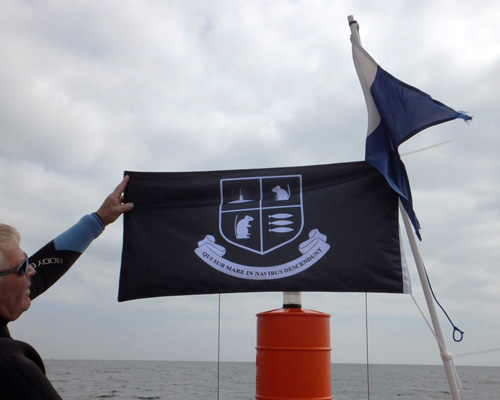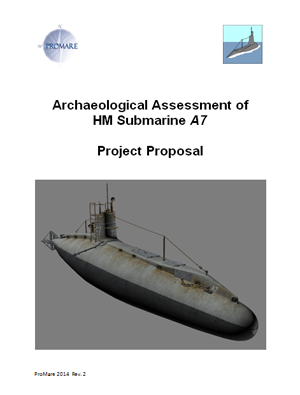Project 1: Project Management
Inception and Permissions
The idea for the A7 Project came from an email discussion in July 2013; the SHIPS Project team had been researching and mapping all of the shipwrecks around Plymouth and the A7 submarine was one that had not yet been investigated. January 2014 was also the 100th anniversary of the sinking of A7 so it would be an appropriate time to commemorate the loss. The submarine is a designated war grave so diving without permission is not allowed, it was designated in 2002 under the Protection of Military Remains Act 1986 as a ‘Controlled Site’ (see now Protection of Military Remains Act 1986 (Designation of Vessels & Controlled Sites) Order 2008: SI 2008/950) ).
Controlled Sites are designated areas of seabed comprising the remains of a military aircraft or a vessel sunk or stranded in military service less than two hundred years ago. It is an offence within a Controlled Site to tamper with, damage, move or unearth any remains, enter any hatch or opening or conduct diving, salvage or excavation operations for the purposes of investigating or recording the remains, unless authorised by licence. Since unauthorised investigation is prohibited, it is accepted that any unlicensed diving is prohibited on these sites.
Previous applications for permission to dive the site made to the UK Ministry of Defence (MoD) by other groups and organisations had not been successful. Discussions were had with the MoD and we were invited to submit a project plan in MoRPHE format that would describe the diving operations we would like to undertake and what the project would deliver to the MoD after the work was complete. They also stipulated that ultrasonic thickness measurements were to be made of the submarine's hull as part of the project.
The team then worked out what work we would like to do which was written down as a series of aims and objectives. From these aims a proposal document was written which described how the work was to be done and this was then sent to the MoD in January 2014, followed by a list of the names of the divers who were to be included on the license. The license was granted in April 2014 for 60 days, but it was noted that any licence 'would be granted on an exceptional basis and because of the mutual benefit that the project would generate both to the MOD and the SHIPS Project '. All project personnel were made aware of the restrictions imposed by this Act and any specific licence conditions and were required to abide by them at all times as a condition of their continued participation on the project.
Click here to download a copy of the project proposal.
Project Aims
- To conduct a marine geophysical survey of the site to yield information on the position, orientation and condition of the submarine
- To conduct a non-intrusive diver photographic survey of the wreck. This would give a detailed baseline survey of the condition of the wreck enabling any further degradation to be assessed
- To conduct a non-intrusive diver survey of any existing damage to the submarine and where possible to determine the cause
- To measure plate thickness at points on the hull to establish a baseline survey of the condition of the hull in 2014
- To learn more about why and how the boat sank
- To conduct a public outreach programme associated with the Project including:
- A public lecture, to be held at Plymouth University in conjunction with the Marine Institute
- A public display at Devonport Heritage Centre
- Development of a virtual reality (VR) model of the site, with the University of Birmingham
- An expanded section on the SHIPS Project web site shipsproject.org
- To make available the results and data from the project to the MOD, to the Historic Environment Record and other organisations and archives acceptable to the MOD
Protocols
Protocols were defined which described what would happen if during the project the team saw human remains, unexploded ordnance or environmental hazards.
Human Remains
As A7 constitutes the last known resting place of the crew who were lost with the vessel the team implemented the following protocol for human remains:
- No intrusive activity was undertaken on the vessel. No attempt was made to enter the hull or to record the interior of the vessel. All photographs and video were taken from outside of the hull.
- Had any images taken from outside the hull inadvertently recorded any human remains these images were not be put into the public domain and would be restricted in circulation to MOD and English Heritage.
- If, in the unlikely event, that human remains were encountered outside the hull the composition and location would be recorded and the matter referred immediately to MOD for further direction. The team would then implement the further directions received from MOD.
Note that the Burial Act 1867 does not apply to human remains on wrecks since these are not deliberate internments.
Unexploded ordnance and environmental hazards
The protocol for unexploded ordnance and environmental hazards was:
- Since A7 was not equipped with a deck gun it was not anticipated that ordnance would be found. It was assumed that the torpedoes present on site would be practice torpedoes which remain within the hull. If any torpedoes were encountered outside the hull they would be recorded but, in accordance with the Project’s ‘no recoveries’ policy, no intrusive activity would be directed at them.
- Since no intrusive activity would be undertaken no environmental risks to divers, beyond the normal diving risks, were envisaged. The existence of any environmental risks encountered e.g. leaking oil, lubricants etc. would be recorded and reported in the Project Report.
Other Permissions

Merchant Shipping Act 1995
As no recoveries of wreck were contemplated by this project proposal no implications arise under this legislation.
Marine & Coastal Access Act 2009
No activity undertaken on the site had a requirement for a marine licence under s.65. A mooring buoy was laid, the Marine Management Organisation were notified and it did not remain in place beyond 28 days so it was exempted under Article 4, para. 22 Marine Licensing (Exempted Activities) Order 2011 (as amended)(S.I. 2011/409).
Since, with the exception of anchors and shot weights, no objects were to be deposited on the seabed by a vessel or recovered from the seabed using lift bags or a vessel, no licence requirement was triggered. The deposition of anchors and shot weights is an exempted activity (Article 4, para. 26A 2011 Order).
Project Flag
A replica of the original but unofficial Royal Navy submarine service flag was made so that it could be flown during project dives on the wreck site. The emblem on the flag has one quarter showing the profile olf an A class boat, another with three torpedoes and the other two with white mice, the essential crew members who gave early warning of poisonous fumes. The text is in latin but means 'for those that dive beneath the sea'.


